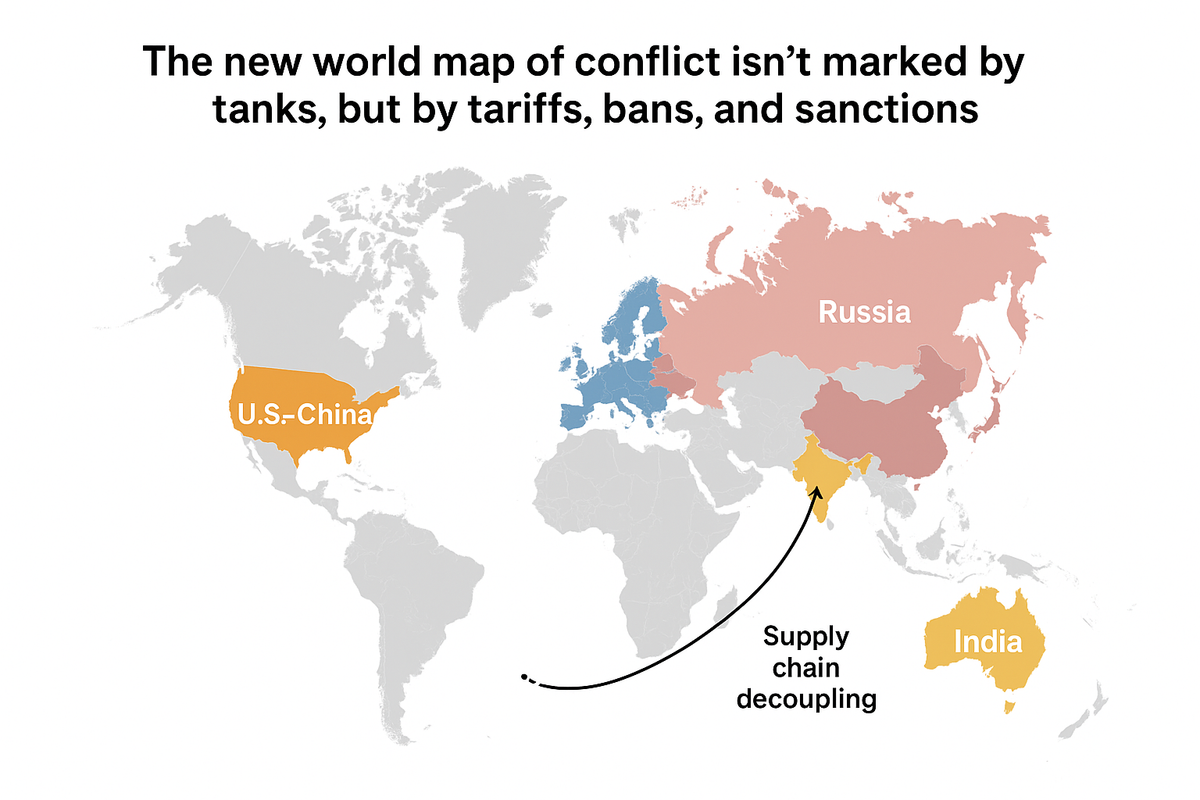Geoeconomics 101: How Trade Wars Are Replacing Shooting Wars
War has changed shape. Instead of missiles and soldiers, today’s battles are fought with tariffs, tech bans, and digital currencies. Welcome to the age of geoeconomics where money, trade, and data decide who wins.

For centuries, when nations clashed, it meant soldiers, tanks, and missiles. But the 21st century battlefield looks radically different. Instead of trenches, there are trade tariffs. Instead of tanks rolling across borders, there are sanctions strangling economies. Instead of bullets, there are digital currencies, supply chain chokepoints, and semiconductor bans. Welcome to Geoeconomics 101 the age where economics, not armies, is the preferred weapon of power.
In this world, trade wars are increasingly replacing shooting wars. Nations no longer need to risk the chaos of bloodshed when they can cripple each other through tariffs, currency manipulation, and technological embargoes. The fight for dominance is waged in boardrooms, central banks, and trade negotiation halls.
The Rise of Economic Warfare
Military conflicts are expensive, unpredictable, and politically risky. Economic warfare, on the other hand, offers a quieter but equally devastating alternative. When the U.S. slapped tariffs on Chinese steel, or when Beijing restricted rare earth exports, the reverberations were felt across global industries without a single bullet fired.
This isn’t new sanctions against Cuba, Iran, and Russia have been part of the Western playbook for decades. But what’s different today is scale and speed. Digital globalization means that a sanction, a tariff, or a supply chain disruption can spread like wildfire, shaking stock markets and emptying supermarket shelves overnight.
Global Supply Chains as Battlegrounds
Supply chains are the arteries of the modern world. From microchips in Taiwan to cobalt in Congo to wheat in Ukraine, every product you use is part of a fragile, interconnected system.
But these arteries are being deliberately rewired. The pandemic exposed just how dependent countries were on Chinese factories. Add the Russia–Ukraine war, and suddenly food, fertilizer, and energy became weapons of leverage. Nations are now pursuing “friend-shoring” moving critical supply chains to trusted allies.

For example:
- Semiconductors: Taiwan produces over 60% of the world’s chips. That’s a geoeconomic vulnerability for both China and the U.S. The result? Massive investments in U.S. chip plants, Japanese subsidies for advanced fabs, and European Union’s “Chips Act.”
- Energy: Europe learned the hard way after decades of relying on Russian gas. The Ukraine war forced a dramatic pivot toward U.S. LNG, renewables, and Middle Eastern suppliers.
- Food: Climate shocks and conflicts have made food exports a bargaining chip. Countries like India have banned wheat exports to secure domestic supply, triggering ripple effects in Africa and Asia.
Supply chains are no longer just about efficiency. They’re about strategic survival.
Tariffs and Trade Wars as Modern Siege Engines
In medieval times, kings laid siege to enemy castles to starve them into submission. In today’s geoeconomic battlefield, tariffs serve the same function.
The U.S.-China trade war that began in 2018 continues to shape the global economy. Tariffs worth hundreds of billions have been imposed, pushing companies to rethink where they manufacture and source goods. While both sides claimed to stand strong, the real casualties were global consumers and businesses facing higher costs.
But tariffs are also political theater. Leaders can flex their “tough on trade” muscles without ever mobilizing troops. The message is clear: cross us, and your exports will suffer.
Digital Payment Blocs: The New Financial Frontline
Perhaps the most underappreciated geoeconomic battlefield is in digital payments and currencies. Money itself is being weaponized.
- SWIFT Exclusions: The U.S. and EU’s decision to cut Russia off from the SWIFT payment system after its invasion of Ukraine was like detonating a financial bomb. Suddenly, Russian banks were locked out of global finance.
- CBDCs (Central Bank Digital Currencies): China’s digital yuan is more than a fintech experiment it’s a geopolitical tool to bypass U.S.-controlled dollar systems. India, Europe, and even smaller economies are racing to issue their own CBDCs.
Dollar Dominance Under Attack: For decades, the U.S. dollar has been the world’s reserve currency. But BRICS nations (Brazil, Russia, India, China, South Africa) are exploring alternatives, from digital coins to gold-backed settlements.

Financial power is no longer only in Wall Street or central banks. It’s in blockchains, fintech platforms, and state-backed digital currencies.
Tech Bans: Silicon as a Weapon
Technology is the crown jewel of geoeconomics. Whoever controls cutting-edge tech controls the future. That’s why the fiercest battles today are about chips, AI, and telecom infrastructure.
- Semiconductor Bans: The U.S. has blocked China’s access to advanced chipmaking equipment, with allies like the Netherlands and Japan joining in. The goal is to freeze China’s progress in AI and military tech.
- 5G Wars: Remember the Huawei saga? The U.S. pressured allies to ban the Chinese telecom giant from building 5G infrastructure, citing security risks. This wasn’t just about antennas it was about who sets the digital backbone of the 21st century.
- AI Arms Race: Countries aren’t just competing in AI development; they’re competing in who controls the rules, data, and computing power that fuel it.
In short, silicon wafers are the new oil barrels scarce, strategic, and weaponizable.
Economic Sanctions as Precision Strikes
Sanctions have become sharper and more targeted than ever before. Instead of blanket bans, countries now use precision sanctions blacklisting specific companies, oligarchs, or industries.
This allows governments to apply maximum pressure with minimal collateral damage. But it’s also risky: sanctions can backfire, driving countries into alternative systems. Russia, for example, has deepened economic ties with China, India, and the Middle East after Western sanctions.
The unintended consequence of sanctions is often the creation of parallel economic blocs, further fracturing globalization.
Winners and Losers in the New Geoeconomics
Who benefits when economics replaces warfare?
- Winners:
- Middle powers like India, Turkey, and Vietnam, which can play both sides to attract supply chains and investments.
- Energy exporters like Qatar, Saudi Arabia, and the U.S., whose commodities become leverage in crises.
- Tech innovators who can position themselves as indispensable in supply chains (think Taiwan, South Korea).
- Losers:
- Nations overly dependent on a single supplier or market.
- Economies locked out of financial systems (e.g., Russia, Iran).
- Consumers worldwide, who pay higher prices as trade wars escalate.
The Return of Economic Nationalism
Geoeconomics is also fueling a return to economic nationalism. Countries are rediscovering the idea of self-reliance reshoring factories, stockpiling resources, and protecting “strategic industries.”
But nationalism cuts both ways. It may strengthen sovereignty, but it also risks fragmenting global cooperation. Instead of one integrated global economy, we may see competing blocs: a Western bloc, a China-Russia bloc, and a non-aligned middle ground.

The Future: Wars Without Gunfire
So, are shooting wars truly being replaced? Not entirely. Military conflict still looms large in flashpoints like Taiwan, the Middle East, and Eastern Europe. But increasingly, nations are discovering that economic pressure can achieve political goals faster, cheaper, and with fewer headlines of human loss.
The battlefield of the 21st century is your supply chain, your smartphone, your grocery bill, and your payment app.
The winners won’t just be those with the biggest armies but those with the most resilient economies, the smartest trade strategies, and the tightest grip on global financial flows.
Conclusion
Welcome to the new age of power. Geoeconomics has become the frontline where superpowers test each other’s resolve. The question isn’t whether trade wars will replace shooting wars it’s how long nations can fight these economic battles before tensions spill into real-world conflicts.
In this silent war, tariffs are the arrows, sanctions the bombs, and digital currencies the new nuclear deterrent. And just like traditional wars, the world will be divided into winners, losers, and survivors.
Sources :
- World Trade Organization (WTO) – Official reports on global trade flows and tariff disputes.
- International Monetary Fund (IMF) – Analyses on supply chain disruptions and global economic outlook.
- World Bank – Insights into digital trade, payment systems, and global connectivity.
- Council on Foreign Relations (CFR) – Articles on U.S.–China trade wars and strategic decoupling.
- Brookings Institution – Research on technology bans and the geopolitics of semiconductors.




